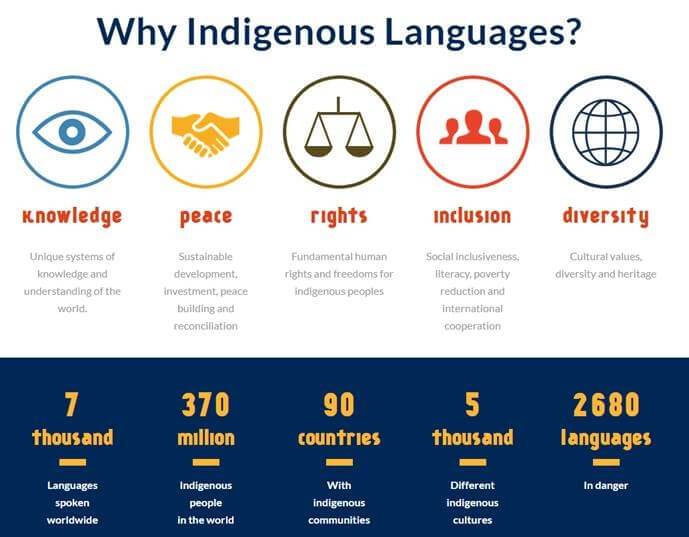Posted on Friday, February 15th, 2019
Did you know that all racism is not experienced equally? Many different racialized groups face challenges related to specific biases, stereotypes and barriers based on their unique history and societal context.
What is Anti-Black Racism (ABR)?
Anti-Black racism is prejudice, attitudes, beliefs, stereotyping or discrimination that is directed at people of African descent and is rooted in their unique history and experience of enslavement and colonization. Anti-Black racism is deeply embedded in Canadian institutions, policies and practices, to the point that it becomes a part of our systems. Anti-Black racism is micro (as seen in day-to-day interactions) and it is structural (as seen in laws and policies that govern this country). (Toronto For All, Confronting Anti-Back Racism Initiative)
What impact does ABR have at work and in our communities?
Anti-Black racism is embedded in institutions, socializing Canadians of all racial backgrounds (including other racialized non-Black people) to be inherently anti-Black. This makes it more difficult for Black Canadians to name their specific experiences of Anti-Black Racism. Often doing so, comes with severe consequences such as: loss of employment, targeting, isolation, violence, and emotional and spiritual injuries. (Toronto For All, Confronting Anti-Back Racism Initiative)
Here are the facts demonstrating the impact of ABR in our communities:
- In 2011, Black high school students had lower graduation rates (64.5%) compared to the overall student population (78.6%); 22.8% dropped out compared to 14.1%. (TDSB Black Students Report) This means there is a barrier for getting black students into our classrooms, and a barrier for us to increase the talent pool of black talent.
- Racialized Ontarians also have higher unemployment rates: 10.5 percent as compared to 7.5 percent for the rest of Ontarians. (Wellesley Institute, Colour Coded Labour Market) This means there is an untapped talent pool available to us as an employer that we should be equipped to connect with.
- Only 7% of employed African-Canadians held management positions, compared with 10% of the overall labour force (Statistics Canada, 2001). This demonstrates that we aren’t accessing all of the diverse perspectives required for creative solutions.
- Visible minority women earn 84.4% of what visible minority men earn, based on median annual income for full-time workers. Visible minority women earn 70.1% of what all men earn. (Statistics Canada 2017)
What can I do about ABR? (Centennial College)
- Acknowledge How Racism has Shaped You: Racism is like an invisible gas that we all breathe. Whether we benefit from it or internalize messages that harm us, racism shapes our thinking and actions, often unconsciously, even if we don’t want it to. Once we acknowledge that, we can begin to explore how we contribute to the problem and what we might do to stop it.
- Educate Yourself: Become aware of the holes in your knowledge. Once you are aware of the holes, it is your responsibility to begin filling them in.
- Speak Up and Do Your Part: Too often, the job of speaking out against racism is left to people of colour. This is unfair. To be effective, all people must be willing to do a good part of the heavy lifting.
Posted on Friday, February 8th, 2019
Since its back history month, I thought I would offer context surrounding some of the current media attention related to Blackface, and how that would tie into our discrimination and harassment policies here at AC. So what is blackface, and why is it racist? It’s “just a costume” or “it was ok to dress up like that at some time in the past, why are people so upset?” I think when we know better, we can do better, so read on to learn the problematic past associated with blackface.
History and Context
Blackface isn’t just about painting one’s skin darker or putting on a costume. It invokes a racist and painful history. The origins of blackface date back to the minstrel shows of mid-19th century. White performers darkened their skin with polish and cork, put on tattered clothing and exaggerated their features to look stereotypically “black.” The first minstrel shows mimicked enslaved Africans on Southern plantations, depicting black people as lazy, ignorant, cowardly or hypersexual, according to the Smithsonian’s National Museum of African American History and Culture (NMAAHC).
The performances were intended to be funny to white audiences. But to the black community, they were demeaning and hurtful. One of the most popular blackface characters was “Jim Crow,” developed by performer and playwright Thomas Dartmouth Rice. As part of a traveling solo act, Rice wore a burnt-cork blackface mask and raggedy clothing, spoke in stereotypical black vernacular and performed a caricatured song and dance routine that he said he learned from a slave.
Such negative representations of black people left a damaging legacy in popular culture, especially in art and entertainment. Minstrel shows were usually the only depiction of black life that white audiences saw. Presenting enslaved Africans as the butt of jokes desensitized white Americans to the horrors of slavery. The performances also promoted demeaning stereotypes of black people that helped confirm white people’s notions of superiority. (https://www.cnn.com/2019/02/02/us/racist-origins-of-blackface/index.html )
Contrary to popular belief, blackface minstrelsy was a popular form of entertainment in Canada, much as it was in the United States. American minstrel troupes travelled frequently to perform in Canada, while Canada also had its own minstrel troupes such as the Saskatoon Minstrels and the Ardrossan Snowflake Amateur Minstrels. (https://mcgill.ca/aapr/blackface-canada )
Intent vs. Impact
When blackface incidents occur today, they spark intense debate, with many attempting to justify it as harmless fun, and in some cases suggesting that those who are offended by it are “too sensitive” or bound by unwarranted “political correctness.” Paradoxically, these claims are based upon elaborate popular Canadian mythologies that suggest (erroneously) that racism has had little relevance in its history, and that any racism there might have been has been overcome (Howard, 2017). Nevertheless, contemporary blackface draws quite clearly on racial tropes—fried chicken, dreadlocks, monkeys. At the same time, and very importantly, it draws upon the ways that blackness is conceived of in dominant Canadian discourse today—most notably as foreign. In modern discussion over blackface, its racist history is often swept under the rug or shrouded in claims of ignorance. Minstrelsy, comedic performances of ‘blackness’ by whites in exaggerated costumes and makeup, cannot be separated fully from the racial derision and stereotyping at its core. (https://mcgill.ca/aapr/blackface-canada )
Algonquin’s HR22 Respectful Workplace policy defines discriminatory harassment as “One or a series of vexatious comment(s) or conduct related to one or more of the prohibited grounds that is known or ought reasonably to be known to be unwelcomed/unwanted, offensive, intimidating, derogatory or hostile. It may include, but is not limited to, gestures, remarks, jokes, taunting, innuendo, display of offensive materials, offensive graffiti, threats, verbal or physical assault, imposition of academic penalties, hazing, stalking, shunning or exclusion.” When we consider workplace discrimination and harassment, an investigation would typically not only give weight to the intent or motive of the perpetrator that matters e.g. “I didn’t mean to be rude/racist – it was a joke”, but would significantly examine the impact or negative effect that that behaviour has on the complainant. The example of blackface is a good reminder to continue educating yourself on the history of racism and be aware of the potential impact your actions can have on others – regardless of what your intent may be.
Posted on Friday, January 4th, 2019
The United Nations General Assembly proclaimed 2019 as the International Year of Indigenous Languages (IYIL). Currently, 40% of the estimated 6,700 languages spoken around the world are in danger of disappearing. The fact that most of these are Indigenous languages puts the cultures and knowledge systems to which they belong at risk. Here in Canada:
- In 2016, 260,550 Aboriginal people reported being able to speak an Aboriginal language well enough to conduct a conversation.
- The number of Aboriginal people who could speak an Aboriginal language has grown by 3.1% since 2006.
- The number of Aboriginal people able to speak an Aboriginal language exceeded the number who reported an Aboriginal mother tongue. This suggests that many people, especially young people, are learning Aboriginal languages as second languages.
- More than 70 Aboriginal languages were reported in the 2016 Census.
- Speakers of languages in the Algonquian, Inuit and Athabaskan language families accounted for 92.6% of Aboriginal language speakers in Canada.
In addition, Indigenous peoples are often isolated both politically and socially in the countries they live in, by the geographical location of their communities, their separate histories, cultures, languages and traditions. And yet, they are not only leaders in protecting the environment, but their languages represent complex systems of knowledge and communication and should be recognized as a strategic national resource for development, peace building and reconciliation. They also foster and promote unique local cultures, customs and values which have endured for thousands of years. Indigenous languages add to the rich tapestry of global cultural diversity. Without them, the world would be a poorer place. Of particular interest to us here at Algonquin College, we should note that the Truth and Reconciliation Commission Calls to Action number 16 reads “We call upon post-secondary institutions to create university and college degree and diploma programs in Aboriginal languages.”
I invite all of us to find ways to celebrate IYIL2019 to help promote and protect indigenous languages and improve the lives of those who speak them.
Posted on Friday, December 7th, 2018
Today is the fifth day of Hanukkah which begins on the eve of Kislev 25 and continues for eight days. The Hebrew word Chanukah means “dedication,” and is thus named because it celebrates the rededication of the Holy Temple. Also spelled Hanukkah (or variations of that spelling), the Hebrew word is actually pronounced with a guttural, “kh” sound, kha-nu-kah, not tcha-new-kah.
The festival marks the phenomenal victory of a group of Jews called the Maccabees over the Syrian Greeks, the most powerful army of the ancient world. At the end of the three-year war, the Maccabees recaptured Jerusalem and rededicated the temple. When the Maccabees rededicated the temple, they discovered a single cruse of oil with the seal of the High Priest still intact. When they came to light the eight-branched temple candelabrum, the menorah, they had enough oil to last only a day. But the menorah miraculously stayed alight for eight days. This became known as the miracle of the oil.
Thus, at the heart of the festival is the nightly menorah lighting. The menorah holds nine flames, one of which is the shamash (“attendant”), which is used to kindle the other eight lights. Each night a flame is lit, and by the eighth night of Chanukah, all eight lights are kindled. Special blessings are recited, often to a traditional melody, before the menorah is lit, and traditional songs are sung afterward. Since the Chanukah miracle involved oil, it is customary to eat foods fried in oil. On Chanukah, it is customary to play with a “dreidel” (a four-sided spinning top bearing the Hebrew letters, nun, gimmel, hei and shin, an acronym for nes gadol hayah sham, “a great miracle happened there”). The game is usually played for a pot of coins, nuts, or other stuff, which is won or lost based on which letter the dreidel lands when it is spun. Here’s the menorah in my shared office:
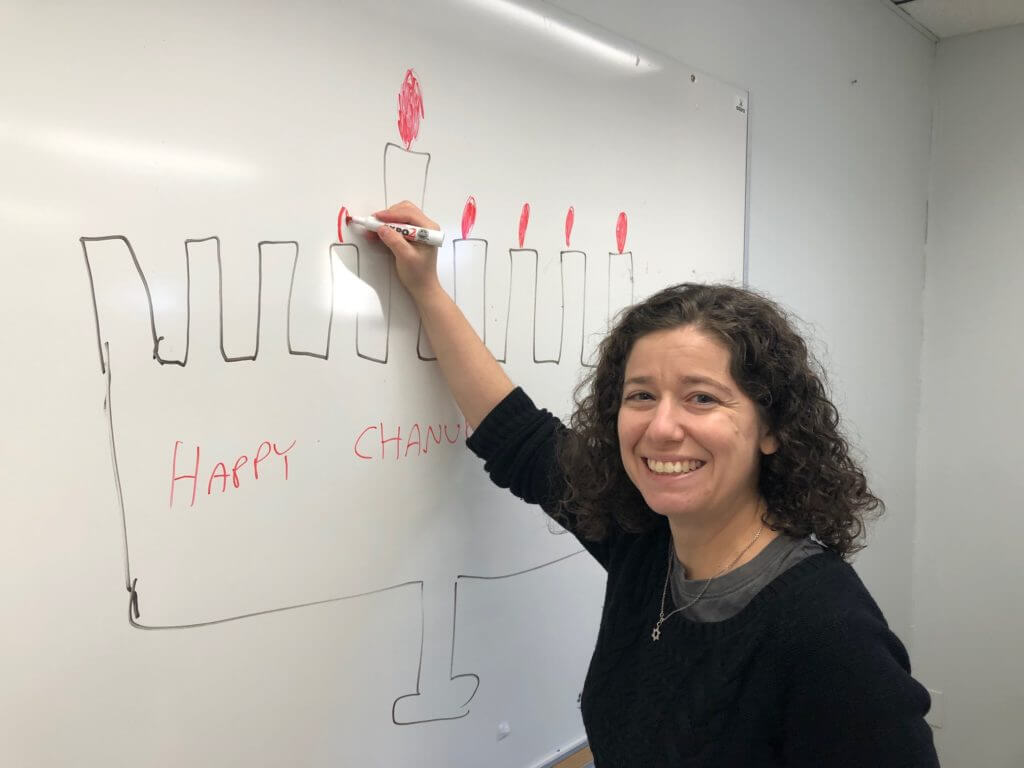
Today people tend to place great importance on giving Chanukah gifts. However, the tradition is to give Chanukah gelt, gifts of money, to children. In addition to rewarding positive behavior and devotion to Torah study, the cash gifts give the children the opportunity to give tzedakah (charity). This has also spawned the phenomenon of foil-covered “chocolate gelt.”
Here is my favourite lesson signified by the candle – “Never be afraid to stand up for what’s right. Judah Maccabee and his band faced daunting odds, but that didn’t stop them. With a prayer on their lips and faith in their heart, they entered the battle of their lives—and won. We can do the same.”
Chanukah is not a Jewish high holiday that may see requests for leave as with Rosh Hashanah or Yom Kippur. However learning about the celebrations of many cultures and having curiosity about them is a key skill of an inclusive leader.
Posted on Friday, November 30th, 2018
This week I’m sharing some research from the Harvard Business Review by Williams and Multhaup entitled ‘For Women and Minorities to Get Ahead, Managers Must Assign Work Fairly’ (read the full article here). I’ve chosen this as particularly relevant for us here at AC, as we see higher numbers of turnover from our Visible Minority employees than any other group.
There are two types of extra assignments at work:
1. Glamour work gets you noticed by higher-ups, gives you the opportunity to stretch your skills with a new challenge, and can lead to your next promotion. It’s the project for a major client, the opportunity to build out a new team, or the chance to represent the company at an industry conference.
2. Office housework happens outside of the spotlight. Some is administrative work that keeps things moving forward, like taking notes or finding a time everyone can meet. Some is emotional labor (“He’s upset — fix it.”). Some is work that’s important but undervalued, like initiating new processes or keeping track of contracts. This kind of assignment has to get done by someone, but it isn’t going to make that person’s career.
Guess who gets which type of extra assignment according to research?
· Female engineers of color were 35% less likely than white men to report having equal access to desirable assignments; white women were 20% less likely.
· For lawyers, women of color were almost 30% less likely than white men to say they had equal opportunity to high-quality assignments, and white women were 18% less likely.
How Team Managers Can Fix the Problem!
1. identify what the office housework is in your department and who is doing it. Make a list of regularly recurring housework tasks and ask your team how often they do each task and how much of their time it takes up (here’s a sample survey for guidance).
2. Don’t ask for volunteers when assigning these tasks – establish a system for making sure everyone takes a turn at office housework.
3. If there’s someone on your team who never gets asked to do office housework because they “don’t do it very well”. that’s a performance problem. It should be addressed like any other performance issue.
4. If you hear comments like “I ask women to plan the parties because they’re better at it” or “I ask women to do those kinds of things because they’re more organized.”, interrupt that thought pattern as that kind of thinking can lead to a toxic environment where women are expected to take on and excel at unrewarding tasks, while men’s time is protected for more remunerative work.
5. For new glamour work assignments, consider all eligible employees, not just the ones who come to mind first or who ask to do it. Formalize the pool of employees with the requisite skills by writing it down. Establish a rotation of plum assignments with the pool. While your rotation system for office housework can be somewhat arbitrary, your rotation for more important assignments should be strategic; you’ll want to match the job to the person much more carefully. Be methodical about how you hand out these tasks.
Posted on Friday, November 23rd, 2018
This week was the observance of the Transgender Day of Remembrance. This is an annual observance on November 20 that honors the memory of those whose lives were lost in acts of anti-transgender violence, and to bring attention to the continued violence endured by the Two-Spirit, trans, and gender diverse communities. The Transgender Day of Remembrance was started in 1999 by transgender advocate Gwendolyn Ann Smith as a vigil to honor the memory of Rita Hester, a transgender woman who was killed in 1998. The vigil commemorated all the transgender people lost to violence since Rita Hester’s death, and began an important tradition that has become the annual Transgender Day of Remembrance.
Here’s something you can do starting today – learn to communicate more inclusively:
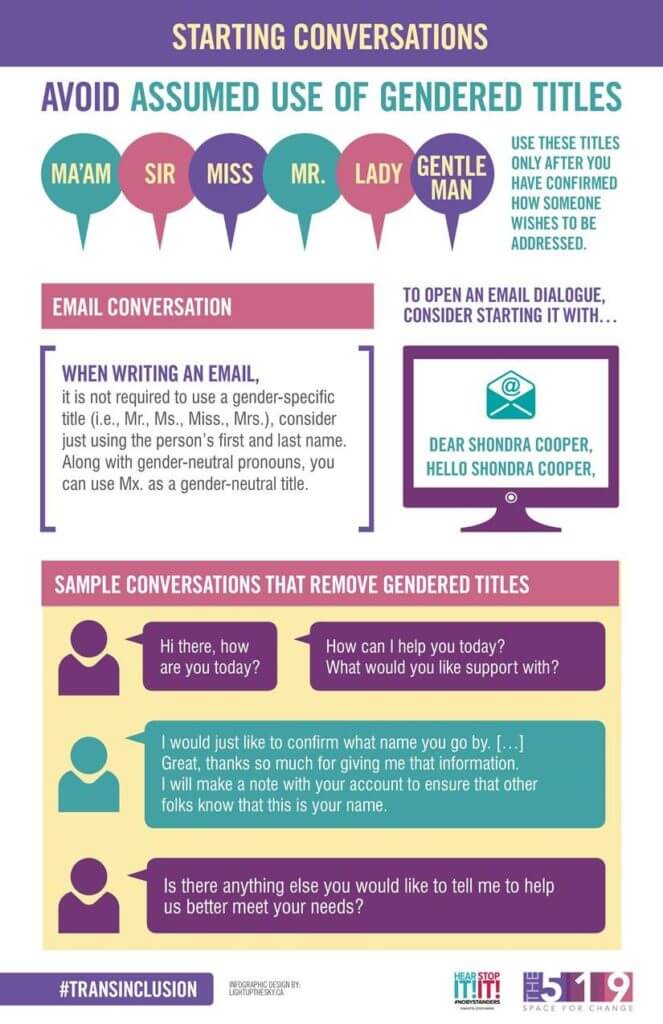
Posted on Friday, November 9th, 2018
Todays’ Friday facts is more aptly titled Friday reflection.
Deloitte conducts an annual survey of Global Human Capital Trends, and tracks the perceived importance of I&D in corporate success. As a culmination of this survey and seven additional major research studies, they have identified there eight powerful truths about inclusion and diversity. I have include below two from Deloitte’s research that apply to managers and leaders, and I hope inspire some reflection.
- Inclusive leaders cast a long shadow: Deloitte’s research shows that the behaviors of leaders (be they senior executives or managers) can drive up to 70 percentage points of difference between the proportion of employees who feel highly included and the proportion of those who do not. Inclusive leadership is broader and a much more intentional and effortful process than just being nice to people. In essence, inclusion of diversity means adaptation. Leaders must alter their behaviors and the surrounding workplace to suit the needs of diverse talent, ideas, customers, and markets.
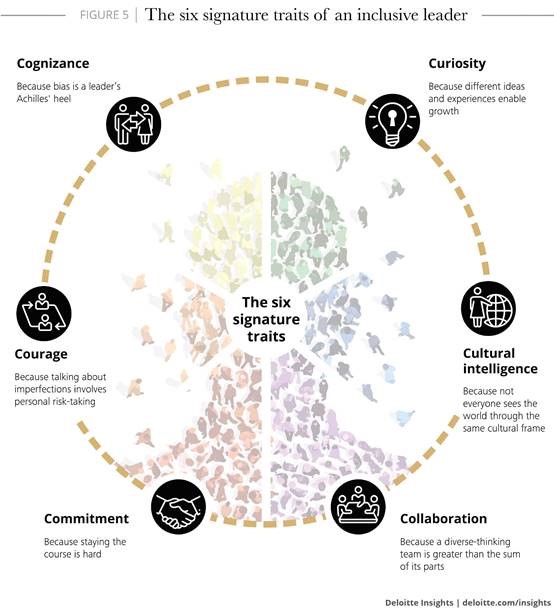
- Middle managers matter: “Ah, the middle managers conundrum, the grassroots are energized, the executives have seen the light, and the top-down and bottom-up momentum comes to a screeching halt right in the middle girth of most organizations.” While change needs to be driven from the top, the middle manager cohort is vital to the success of an organization’s diversity and inclusion strategy. Managers can react to inclusion and diversity efforts in a variety of ways – consider where you might be and where your reports are:
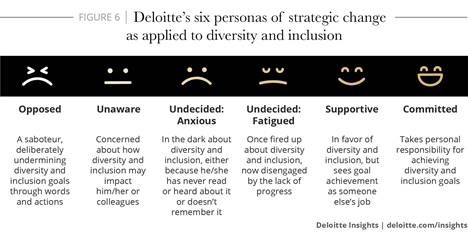
Leaders can influence middle managers using multiple tactics, including:
- Using storytelling to help move people emotionally and engage them on the purpose of the D&I agenda. For example, senior leaders could share their personal stories of commitment.
- Addressing myths and misconceptions by ensuring that middle managers understand the fundamentals—for example, by communicating the difference between equality and equity.
- Having open conversations to enable questions and concerns to be surfaced. Senior leaders should enter these conversations with curiosity and courage—two of the trademark characteristics of highly inclusive leaders.
- Exposing middle managers to influential role models and other powerful experiences, such as putting them on high-performing, diverse teams; presenting them with counter-stereotypic examples; offering them mentoring opportunities; and giving them experiences that put them in the minority. These tactics should help managers walk in someone else’s shoes and enable perspective-taking.
- Making tough decisions when needed to ensure that the organizations’ values are upheld. Inclusion is not a euphemism for “anything goes.”
